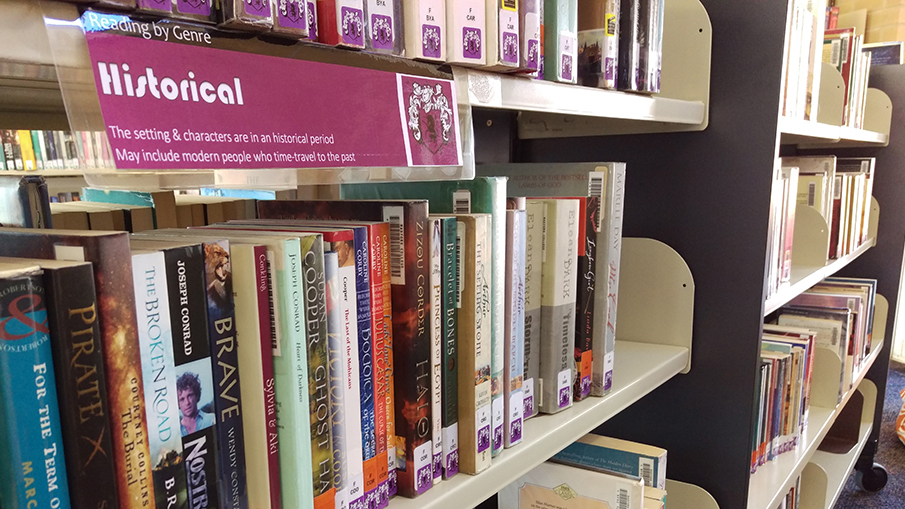Issue 102
Term 3 2017
Genrefying the fiction collection
Radford College recently genrefied their senior library's fiction collection. Susan Davenport discusses the genrefication process, and how the school community has responded.
‘What sort of books do you like reading?’ and ‘What do you do outside school?’ are two questions that I regularly find myself asking students looking for something to read. Usually the answer is a variation on ‘I dunno’, ‘Anything!’ or ‘Stuff’.
Early in 2016, several things were on our radar regarding Radford College Library’s 5–12 Fiction Area:
- How do our students choose books to read?
- Do we provide enough support to make selecting books straightforward?
- Does the physical space and its furnishings meet client needs?
The fiction collection
In early 2016, our 8,000+ book fiction collection included a mixture of wall and static double-sided shelves and spinners; three small collections for graphic novels, biographies and audiobooks; and separate shelving for years 5–6 books — all organised by author (A–Z). Some book spines had genre stickers: some with up to three labels, and many with none. After much discussion about our library space and genres, it was clear we needed to review our whole genre-labelling system.
Lyn Hay presented a timely Syba Academy seminar, ‘Rethinking the collection: principles and practice for 21C school libraries’, and our four teacher librarians were given the opportunity to attend. As the reasoning for genrefication unfolded, it was clear that we were on the cusp, and hadn’t realised it. We resolved to bring this topic up for open discussion with the library team upon our return.
After we received the support of the leadership team and the English department, we talked to the students and seeded the idea that the fiction area would be changing.
Why genrefy?
Organising the collection by author is logical. It’s clear, rarely subjective, and makes the books easy to locate — if you’re searching by author. We observed that our students know some authors, but not many, and are more likely to read in genres.
When considering the questions I regularly ask students, I realised that I ask about genre as well. When a student says they enjoyed reading about sport, we then hunt for a book with a sport label, or search the catalogue, which may use ‘Sport — Fiction’ or a narrower term like ‘Gymnastics — Fiction’.
After brainstorming our organisation process with the secondary library’s staff (teacher librarians, techs, and assistants), we embarked on the following:
- to group books based on genre, then by A–Z within each
- to expand the number of genres
- to review each book in our fiction collection, assign it a genre, and record it on both the item and its catalogue record
- to change each book’s catalogue collection to the genre shelf instead of the ubiquitous ‘Fiction’, eg Harry Potter; Branch: Secondary Library; Collection: Fantasy; Classification: F ROW
- to use an orange spine label for books suitable for years 5–6 and white for 7–12, and to interfile them in the genres
- to use funds allocated for library refurbishment to purchase new portable shelving.
Genres
There was much debate around genres. We tried to tie many of them to the units studied by the English classes, particularly those from the new Senior Secondary English Australian Curriculum. We now have 30 different genres1 on their individual shelves. Where we couldn’t source a label from a supplier, we made our own.
There is also a subset of ‘FYI labels’. These are books that feature the following aspects, but are not allocated their own shelves: Aboriginal peoples, Australian, Book to screen, Classical literature, and Translated into English.
Surveying our students
We sent out an electronic survey for our years 5–12 students to complete voluntarily. While only 24 per cent responded, it gave us an overview across year levels and from frequent and non-frequent fiction readers. For comparative purposes, the questions were designed to be adjusted slightly so that the survey could be repeated mid-Term 4 after the changes. The results showed that there was work to be done in educating our students in how to use the library’s physical and electronic resources, and that our current application of genre labels wasn’t having much effect.
Reviewing the books
We embarked on this lengthy project around our other duties. With preallocated fiction sections, we took a trolley of books off the shelf at a time to perform the following actions:
- review the book for genre allocation using the book’s blurb, SCIS Subject Headings and Goodreads — and brainstorm difficult genre allocations
- print new spine labels if required; for example, where a series is by multiple authors, eg The Quentaris Chronicles, the call number was changed to F QUE
- remove obsolete genre labels from books
- add the new genre label(s) to the book and cover with a clear label
- group like genres near each other; for example, Horror and Supernatural.
Change commences
In the fortnight before our changes were to take place, we warned classes that the fiction area would be closed for about 10 days.
When the new shelving arrived, we moved into action. With assistance from the College’s maintenance team, the new shelving was assembled and the old decommissioned.
The fiction area was cordoned off to isolate the collection. No entry. No borrowing. Students wanting books were able to borrow from the returns trolley. The entry was DIY-curtained, and the windows covered, creating an air of mystery. Student volunteers assisted staff with the reorganisation.

Promotion
To promote the new genrefied collection, we featured each genre via our social media channels, wrote an article in the College’s Bulletin, added lots of signage to the collection, and held a reopening ribbon-cutting ceremony with morning tea. (We opened with it mostly done, catching up later on things like catalogue updating and reviewing returned books.)
Signage in the library included:
- A3 signs created in Word, and featuring each genre’s name, a genre picture, short description, example book covers, popular authors
- a corresponding shelf marker jutting out from beneath the books, featuring the genre picture, explanation and colour
- shelf markers sitting atop the shelves
- an A3 cheat sheet listing all the genres, with pictures and descriptions
- a map of the fiction area
- how-to sheets for using the catalogue to search for a genre, series, title or author.
Reactions to the genrefication
The English and class teachers love it. They feel it is now much easier to help students find something to read, without their needing to know the whole collection. They also like the new layout, which has improved line of sight for supervision.
The students have mostly been quite positive about the change. The hard-core readers are exclaiming that it’s easier for them to find new authors or books similar to what they read. The ‘I don’t know what to read’ students are able to pick a genre and select a book from there. It’s far less overwhelming to choose from two shelves rather than stare at over 8,000 books. One Year 8 lad exclaimed that ‘You finally have books I want to read!’ having selected an Andy Griffiths book from the Humorous section. I refrained from telling him it was there all along.
Being able to search by label colour and theme means that you can find appropriate books for students of all ages and interests who ask you for recommendations at the Loans Desk. A teacher recently sent students down to find dystopian books to match their class novel, which would have been a daunting on-the-spot task two months previously.
Guiding students
After genrefication, as each class came to the library a teacher librarian would do a 15-minute talk about the changes to the collection, why it happened, and how they might locate books using a combination of genre and catalogue. We followed this up for the rest of Term 4, providing low-key guidance and class instruction where needed.
Recommendations
- Weed your collection first. Weed it hard, then weed as you go. You’ll find that you will end up purchasing books to fill the gaps in series and develop smaller genres. Genrefication also takes up more shelving than an A–Z layout.
- Set genrefication as a major project for a set timeframe and prioritise it. Involve as many of your staff in the process as possible.
- Select genres that best align with your collection and your clients’ needs.
- Survey your clients before and after the change.
- Talk to people who have already genrefied. It will help inform your thinking, but keep in mind that every library is unique.
- Work with your catalogue and investigate the features available to you. Factor in the requirements for stocktake, how users will search for books on the OPAC, and how you can use bulk processing to make changes.
- Choose labels that clearly articulate the genre and complement them with prominent signage that explains them.
- Ask a mixture of your clients for their feedback on genres, labels, maps, signage, etc.
- Keep your organisation’s staff and senior management updated.
- Promote the library and the changes you’re making by listening to the feedback from your clients.
- Accept that there are many unknowns and some things you’ll just have to work out as you go.
Moving forward
Keeping the collection current and relevant will be a source of constant revision and renewal. Since our original genrefication, we have reviewed our loans stats and observed that the ‘School’ genre wasn’t moving — so it’s been decommissioned and its books interspersed within other genres. In response to student requests and publishing trends, we’ve added a new genre, ‘Resilience’, to encompass books about people overcoming significant obstacles. Genrefication highlights areas that need development; we will focus on building our ‘Sport’ and ‘LGBT’ genres. I wholeheartedly recommend considering whether a genrefied collection is right for your library. Our library staff have enjoyed the challenges of the genre set-up; our teachers are better able to help their students choose books; students are self-selecting books with greater ease, and our fiction area is more engaging.
Find Radford Secondary Library on Instagram, Facebook and Twitter.
Footnotes
1. Genre shelves in fiction collection
| Adventure | Historical |
| Animals | Horror |
| Arts | Humorous |
| Audiobooks | LGBT |
| Biography | LOTE |
| Coming of age | Mysteries and spies |
| Crime | Romance |
| Cultural | School |
| Dystopian | Science fiction |
| Fact not fiction | Sport |
| Fantasy | Steam punk |
| Friendship and family | Supernatural |
| Funky fairy tales | Survival and refugees |
| Gamer | Travel |
| Graphic novels | War |
Image credits
Photo supplied by Susan Davenport.
